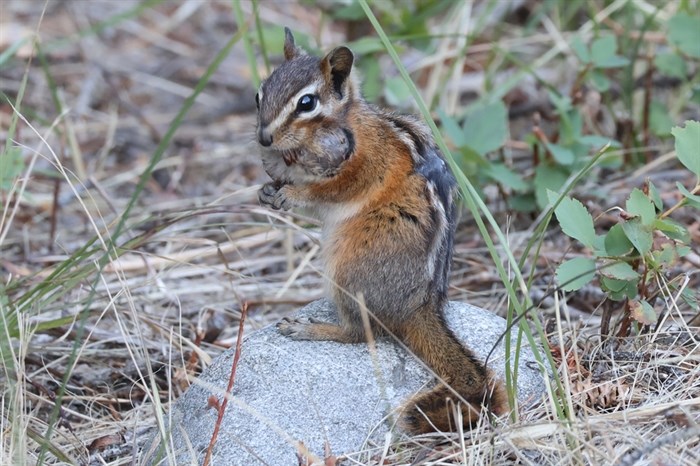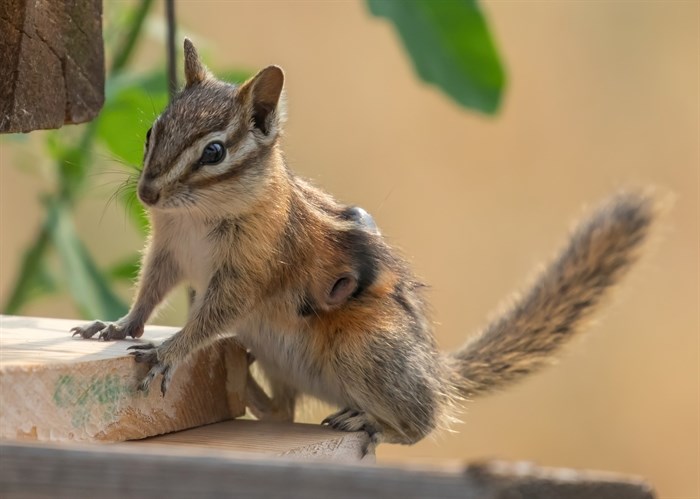
A yellow-pine chipmunk with bot flies in it in Manning Park.
Image Credit: SUBMITTED/ John Pickard
September 04, 2023 - 7:00 AM
Some residents in the BC Interior are seeing chipmunks with strange looking lumps and bumps on their bodies but despite how alarming the condition looks, it isn’t damaging or hurting the critters.
A wildlife photographer in Clinton, Amanda Nelson, took a photo of a yellow-pine chipmunk on one of her photography outings this summer and was shocked when she later took a closer look at the photo.
“There was a hole on his side and two things on his back,” she said. “I wondered why it looked like he had blueberries on his back. I’d never seen it before. It looked painful but he didn’t seem bothered by it.”
Okanagan resident John Pickard recently posted a photo of a yellow-pine chipmunk with the same condition spotted in Manning Park this summer.
Retired wildlife biologist Jeff Boettner determined the lumps seen on the chipmunks are bot fly larvae. Based in Massachusetts, Boettner specialized in parasitic fly work and is currently researching bot flies, including the ones burrowing into yellow-pine chipmunks in BC.
Bot flies are parasitic flies that develop in the bodies of mammals, and some species have larvae that live under the skin of rodents, hares, rabbits, picas, monkeys, livestock and even humans.
“Female bot flies lay up to 2,000 eggs and use a variety of methods to get them into warm-blooded mammal hosts including laying them on a flying blood-sucking insects or laying them where chipmunks run in and out of their dens,” he said. “The eggs can also be ingested through the nose or mouth. The bots hatch from the temperature of the host and live in the host for a month growing into large round maggots. They drop off the host and bury into the ground where they pupate and remain for months until emerging as adult flies.”

A yellow-pine chipmunk with bot flies in it's back in Clinton.
Image Credit: SUBMITTED/ Amanda Nelson
Boettner said while the large round masses look like they should be painful for the chipmunk, the bots don’t hurt their hosts.
“These flies have been living in hosts for millions of years and have evolved to not hurt the host,” Boettner said. “The larvae leaves a kind of antibiotic when it exits that helps heal the wound faster.”
Boettner has an account with INaturalist, an online forum where people can post photos of wildlife, insects and other interesting things that can be useful for researchers. He said in the last two years there has been an increase in photos of yellow-pine chipmunks with bot flies submitted from BC.
He is trying to determine what species of bot fly is involved.
READ MORE: Oliver woman overjoyed to see elusive northern scorpion on her porch
“There hasn’t been a lot of research on this for a long time, so I’m working on it, using modern techniques,” he said. “It’s been known since the 70s that some years the chipmunks get lots of bots in the west but no one knows what species of bot they are getting. No one has really done a lot of research on this. Is this a new species that is undescribed?”
He said in BC there is a general bot that affects mice in the province which could be jumping into chipmunks but it’s unlikely. Because yellow-pine chipmunks have been a recorded host for quite a while, he suspects it is something native to the region.
READ MORE: Exhausted dog rescued from North Vancouver trail
Boettner is looking for photos of yellow-pine chipmunks infected with the larvae, or even better, a sample of the larvae sent to him in the mail for DNA sequencing and identification.
“Even finding a road kill of a yellow-pine chipmunk, as soon as the chipmunk dies, the bot evacuates,” he said. “It’ll crawl out of the host, drop to the ground and try to burrow into the ground to pupate. The bot can’t burrow into the ground on a hard surface and will just pupate right there.”
Go here if you want to share a photo of a bot-infected yellow-pine chipmunk in BC or a collected sample of a bot larvae to help with Boettner’s research.
To contact a reporter for this story, email Shannon Ainslie or call 250-819-6089 or email the editor. You can also submit photos, videos or news tips to the newsroom and be entered to win a monthly prize draw.
We welcome your comments and opinions on our stories but play nice. We won't censor or delete comments unless they contain off-topic statements or links, unnecessary vulgarity, false facts, spam or obviously fake profiles. If you have any concerns about what you see in comments, email the editor in the link above. SUBSCRIBE to our awesome newsletter here.
News from © iNFOnews, 2023